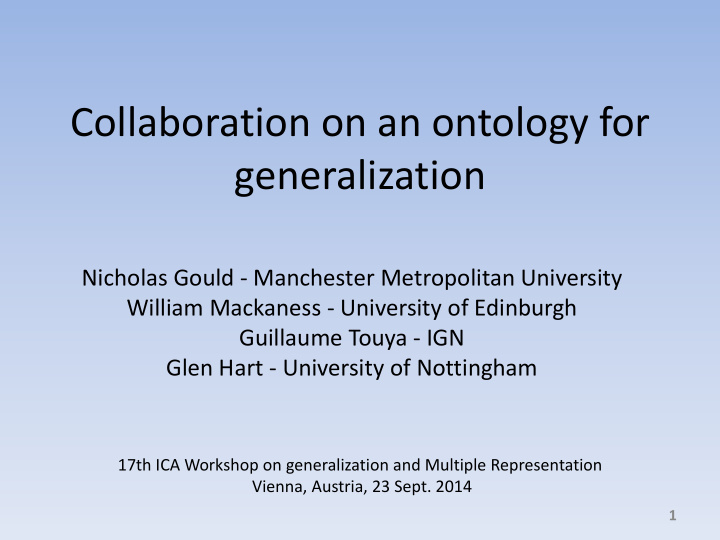



Collaboration on an ontology for generalization Nicholas Gould - Manchester Metropolitan University William Mackaness - University of Edinburgh Guillaume Touya - IGN Glen Hart - University of Nottingham 17th ICA Workshop on generalization and Multiple Representation Vienna, Austria, 23 Sept. 2014 1
Searching for an algorithm… Analysis of Urban Road Networks to Road Network Selection for Small-Scale Support Cartographic Generalization Maps Using an Improved Centrality Approach Thin Road Network A Road Network Selection Selective omission of road features based on Process Based on Data Enrichment and Structure mesh density for automatic map generalization Detection Road network selection using an extended stroke-mesh combination algorithm The ‘Good Continuation’ Principle of Road selection based on Voronoi Perceptual Organization applied to the Generalization of Road Networks diagrams and strokes in map generalization A Structural Approach to the Integration of linear and areal Generalization Model Generalization of an hierarchies for continuous multi- of Geographical Urban Street Network scale representation of road Networks networks Selection of Streets from a Network Using Self-Organizing Generating hierarchical strokes from urban street Maps networks based on spatial pattern recognition 2
Representing cartographic knowledge Formal Generalization Ontologies Software Knowledge Implicit Explicit Cartographers’ Operator Knowledge Taxonomies 3 Informal
Collaboration • An ontology is a “formal, explicit specification of a shared conceptualization” (Studer et al. 1998) • Requires collaboration • Ensure acceptance 4
Capturing the semantics of generalization • Should avoid encapsulating rules • Goal: capture the semantics of generalization – Modelling relationships • Spatial but also geographic • An ontology can (theoretically) model any relationship – hierarchical, topological, partonomic • Support reasoning about generalization 5
Size of the task 6
Benefits • Better sharing of algorithms – what are the characteristics of generalization algorithms? • Support for on-demand mapping • Support for web services - WEBGEN 7
Core skills Neuhaus, F., Florescu, E., Galton, A., Gruninger, M., Guarino, N., Obrst, L., Sanchez, A., Vizedom, A., Yim, P., & Smith, B. (2011). Creating the ontologists of the future . Applied Ontology, 6 , 91-98. Clarifying the purpose of a given ontology, understanding potential • deployment, performing requirements analysis . • Managing ontologies across their life cycle (requirements analysis and planning, managing a systematic update process, versioning, documentation). • Identifying, evaluating and using software tools that support ontology development. • Choosing the appropriate level of detail . • Conducting ontological analysis , that is identifying entities and relationships; formulating definitions and axioms. 8
Core knowledge • The basic terminology of ontology (relation of ontology to knowledge representation, conceptual modeling, data modeling, . . . ). • Theoretical foundations: Set theory, description logic • Ontology evaluation strategies and theories (e.g. Ontoclean). • Representation languages: Resource Description Framework (RDF), Web Ontology Language (OWL) • Reasoning with ontology content; • improving search and retrieval; • decision support , situational awareness, information fusion, anomaly detection. 9
Ontology design methodology • Methodology will provide structure • Number of different ontology design methodologies – UPON, DILIGENT, NeOn, GEONTO-MET, Ontology 101 • Different approaches – Software design life cycle – Collaborative approach • Reviews • Hybrid methodology • Use case 10
Select a use case • Defines the scope and purpose • For example: – Create an ontology that represents sufficient knowledge to allow for the automatic selection of line simplification algorithms or – line simplification and smoothing algorithms or – building amalgamation algorithms or – road selection algorithms 11
Ontological engineering • How do we model a generalization algorithm? – What is an algorithm? • What are the common characteristics? – Is Douglas-Peucker a sub-class of “algorithm” or a label? – Is it an individual(instance) of an operator? – What of the variations of DP? • What are the other concepts? – How do we model scale? Or the consequences of scale change? 12
Tools • webProtégé – allows for collaboration 13
How do we animate this? • Identify partners • Define scope of the ontology • Define ontology design methodology • Define outcomes – Ontology (OWL2) for the use case(s) – Report back to next commission workshop • Identify tools (e.g. webProtégé) • Define project roles – Conceptual – Methodological – Technical – Evaluation • Project plan 14
Conclusion • Cartographers lack the means to systematically document the knowledge required for generalization (Nyerges, 1991) • Now have… – the model - ontologies – the language - OWL – the tools - Protégé and webProtégé 15
Recommend
More recommend